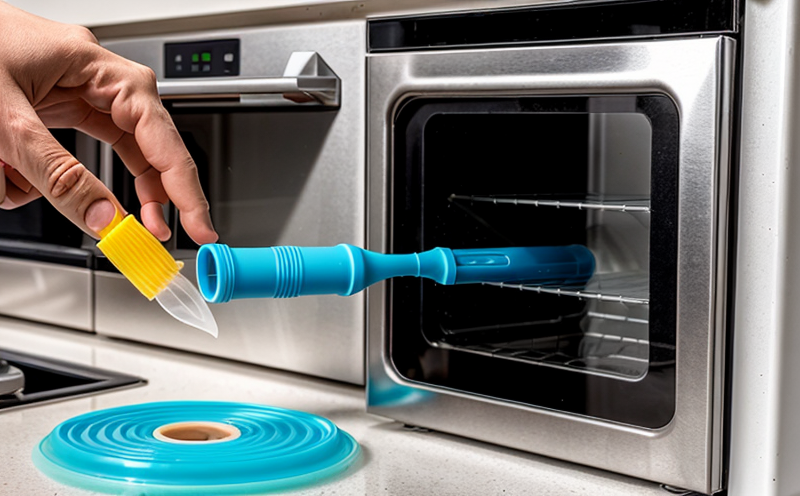ASTM D1693 Environmental Stress Cracking Testing of Household Plastics
The ASTM D1693 standard test method is widely recognized and utilized in industries that demand high reliability from their plastic components, especially those exposed to environmental stresses. This service involves subjecting household plastics to a combination of heat, humidity, and stress to assess their resistance to cracking or failure under these conditions.
The process typically begins with the selection of appropriate specimens made of the target household plastic. These specimens are then subjected to controlled temperature and humidity conditions while being held in a specific loading configuration that simulates real-world stresses they might encounter during use. The duration of this exposure can vary, but it is often set to simulate long-term service life under environmental stress.
For accurate testing, the ASTM D1693 method specifies precise temperature and humidity conditions, which are critical for assessing the plastic’s performance in a controlled environment that mimics real-world conditions. The test results are then compared against standards defined by this protocol to determine if the material meets required specifications. This ensures not only compliance with industry norms but also enhances product reliability and safety.
The ASTM D1693 method is particularly useful for household plastics, such as those used in appliances like dishwashers or washing machines, where prolonged exposure to heat and moisture can lead to cracking of the plastic components. Understanding and addressing these vulnerabilities early in the design process can significantly enhance product longevity and user satisfaction.
Testing according to ASTM D1693 involves a series of steps that ensure accuracy and consistency across multiple samples. Specimens are carefully prepared, ensuring uniformity and representativeness of the material being tested. The specimens are then exposed to heat (typically 75°C) and humidity (80% RH), while being subjected to tensile stress.
Following exposure, the specimens undergo visual inspection for any signs of cracking or failure. Any cracks observed are measured and documented according to standardized criteria defined in ASTM D1693. This detailed documentation ensures that all aspects of the test process can be reviewed and verified by regulatory bodies or clients.
| Use Case/Application | Description |
|---|---|
| Dishwasher Racks | Testing the durability of rack components in harsh household environments. |
| Toaster Parts | Evaluating the performance of toaster parts under stress and heat. |
| Dishwashing Tablets | Assessing the integrity of tablet packaging against environmental stresses. |
| Vacuum Cleaner Parts | Ensuring longevity and reliability in vacuum cleaner components. |
The ASTM D1693 method also ensures that the testing process adheres to international standards, enhancing the confidence of clients and regulatory bodies. This service is essential for manufacturers aiming to produce high-quality household plastics that can withstand environmental stresses without compromising on safety or performance.
Quality and Reliability Assurance
- Precision in specimen preparation, ensuring uniformity across all samples tested.
- Consistent control of temperature and humidity during the test to replicate real-world conditions accurately.
- Thorough documentation and reporting of results for verification by regulatory bodies or clients.
The process begins with meticulous specimen preparation, ensuring that each sample is identical in size, shape, and composition. This uniformity is crucial as it minimizes variability due to differences in the samples themselves. The temperature and humidity conditions are then precisely controlled using calibrated equipment, which ensures that the test environment closely mimics real-world scenarios.
After the specimens have been exposed to heat and humidity for a predetermined period, they undergo a detailed visual inspection. This step is critical as it allows testers to identify any cracks or signs of failure that might not be visible otherwise. The results from this inspection are meticulously documented using standardized criteria defined in ASTM D1693. This documentation ensures transparency and reproducibility, which are essential for maintaining high standards of quality and reliability.
The documentation process is comprehensive, capturing all aspects of the test procedure, including the initial conditions of the specimens, the environmental stress applied, and the resulting observations. This detailed record-keeping not only enhances the accuracy and reliability of the testing but also provides a clear trail for any future audits or reviews by regulatory bodies.
The precision in specimen preparation, controlled environment conditions, and thorough documentation are integral to maintaining the integrity and quality of the ASTM D1693 test. These measures ensure that the results obtained are reliable and can be trusted as they reflect real-world performance accurately.
International Acceptance and Recognition
- ASTM standards, including D1693, are internationally recognized for their accuracy and consistency.
- The method is widely accepted in countries that prioritize high-quality household plastics.
The ASTM D1693 test method has gained international recognition due to its stringent protocols and consistent results. This method is not only used within the United States but also by manufacturers, quality control departments, and regulatory bodies around the world who value reliability in their products.
ASTM standards are recognized for their rigorous testing procedures that ensure compliance with industry norms and safety regulations. The ASTM D1693 test specifically targets household plastics, ensuring they can withstand environmental stress without compromising on performance or safety. This method is widely accepted by various countries due to its ability to provide consistent results across different environments.
Many countries have adopted ASTM standards as a benchmark for quality and reliability in their industries. For instance, the European Union (EU) uses these standards extensively for testing household plastics. Similarly, organizations like the International Organization for Standardization (ISO) often reference ASTM standards when developing global guidelines. This international acceptance enhances trust in the results obtained from this method and ensures that manufacturers can produce products that meet global quality and safety standards.
The widespread use of ASTM D1693 underscores its importance in maintaining high-quality household plastics that are durable, reliable, and safe for end-users. By adhering to this standard, manufacturers ensure their products meet or exceed international expectations, thereby building a reputation for excellence in the global market.





